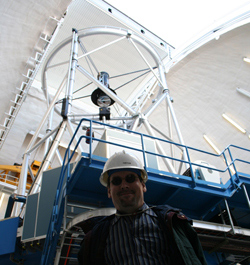 Every activity has its sacred ground. For sports fans, it may be Yankee Stadium or Lambeau Field. For history buffs, perhaps the Giza Plateau or Rome would make the list. For astronomy enthusiasts, one site that consistently tops the list is the summit of Mauna Kea, Hawaii.
Every activity has its sacred ground. For sports fans, it may be Yankee Stadium or Lambeau Field. For history buffs, perhaps the Giza Plateau or Rome would make the list. For astronomy enthusiasts, one site that consistently tops the list is the summit of Mauna Kea, Hawaii.
Not only is Mauna Kea the most expansive collection of important professional telescopes in the world, but, at an elevation of 13,796 feet, it offers possibly the best observing site on Earth. The combination simply cannot be beat. That's why, beginning in the 1960s, the University of Hawaii began to implement plans to construct telescopes on the summit. The dormant volcano lies north of and faces - across a huge valley - the other dormant volcano on the big island of Hawaii, Mauna Loa. Far to the south, as we drove up the mountain, we could spy the smoke rising from the active volcano, Kilauea.
The collection of telescopes atop Mauna Kea reads like a who's who of great world observatories. The twin Keck telescopes, at 10 meters each, the largest in the world, are there. So is the state-of-the-art 8.1m Gemini North Telescope. And the 8.3m Subaru Telescope. I actually heard the other famous optical scope on the mountain, the 3.6-m Canada-France-Hawaii Telescope, described today by its director Christian Veillet, as "small!" Two important infrared telescopes stand on the mountain, the 3.8m United Kingdom Infrared Telescope and the 3m NASA Infrared Telescope Facility. Three submillimeter telescopes are present: the Caltech Submillimeter Telescope, the James Clerk Maxwell Telescope, and the Submillimeter Telescope Array.
I had traveled up Mauna Kea once before, during a Hawaiian astronomy tour sponsored by Astronomy, a number of years ago. This time, the occasion was a press tour organized as a part of the American Astronomical Society meeting held this week in Honolulu. On Thursday, a participating press corps of 30 left its hotel in Hilo early in the morning, ready for 13 hours of travel to and exploration of the world's greatest observatory complex.
Separated into three groups, we began the long drive that would take us from sea level to nearly 14,000 feet in a matter of a few hours. Among those journalists in our van were Astronomy Contributing Editor Martin Ratcliffe, who writes much of "The Sky this Month" each month in the magazine; former Astronomy Senior Editor and now press officer for the Goddard Space Flight Center Bob Naeye; and another Astronomy alum, Maggie McKee of New Scientist.
We began by eating breakfast at the beautiful new Imiloa Astronomy Center of Hawaii, a gorgeous facility with a cutting-edge planetarium and numerous interactive exhibits designed to integrate a love of the sky with native Hawaiian culture. It's a museum that should not be missed by anyone remotely interested in astronomy. The journalists were then treated to a variety of lectures by Mauna Kea scientists, giving us previews of their latest research. Next we trekked to 9,000 feet, high up on Mauna Kea, to rest, and to let our bodies adjust to the diminished oxygen. We had lunch at the astronomers' quarters, where visiting researchers stay.
Spending time at 14,000 feet is serious business. We drove across rough roads peering out onto a landscape that looked alternatively lunar or martian, with vast boulders and debris fields of basalt everywhere. The intense sunlight, harsh winds, and particularly the thin atmosphere play games with many visitors' health. At that altitude, you're breathing only 60 percent of the oxygen you're accustomed to, and so, lightheadedness, headaches, and more serious problems often result. Of 30 travelers, we had only one person who felt seriously ill. Taking things slowly is key: Upon stepping outside and walking around on the summit, the main effect is that it instantly seems like you've had a martini or two.
We saw the Harvard Submillimeter Array, its control room, and the giant platform-tractor that is used to pick up and move the immense dishes. The group then traveled up to the summit itself to walk through an extensive tour of the Gemini North Telescope. It's a spectacular facility, with a breathtaking design, superb instrumentation that can be switched more quickly than with any other large telescope, and current work including brown-dwarf discoveries and a deep survey uncovering distant galaxy clusters.
The crowning act, then, was to see the Keck Observatory. We entered the building, walked through the huge, wide enclosure that separates Keck I and Keck II, and entered the aluminizing room. There, mirror segments are routinely recoated in a huge vacuum chamber; next door, the control room offered a glimpse of what was to come later Thursday night. Finally, we rode an elevator up to the catwalk and examined Keck II, aghast at its sheer scale.
Dinner back at the astronomers' housing followed by the long trip back to Hilo capped the big day. But not before we observed, briefly, from the 9,000-foot level, spotting the Southern Cross and peeking at a couple of telescopic objects before the bright moonlight and the travel schedule drove us off. Thanks to Steve Maran and to Peter Michaud for arranging such a fantastic day. Traveling to the Mauna Kea summit is something every astronomy enthusiast should do at least once in a lifetime.
See more images from the Mauna Kea tour in this photo gallery.